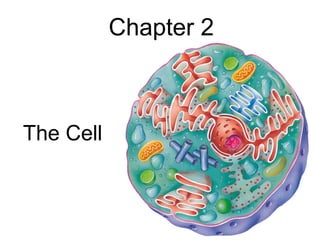Life Science Chapter 2 The Cell
- 2. 2-1 Cells: The Units of Life
- 3. The Microscope: A Tool Q: Why do scientists need to use microscopes? A: Cells are small
- 4. Before…
- 5. Compound Microscope • Combines the power of 2 lenses to enlarge the image and blend light toward your eye
- 6. Eye piece lens X objective lens 10x X 4x = 40x Low power 10x X 10x = 100x Medium Power 10x X = 400x High Power 40x
- 7. Eyepiece or ocular lens • Lens closest to the eye
- 8. Objective Lens • Lens closest to the specimen or object
- 9. Nosepiece • Objectives fastened to this revolving structure
- 10. Stage • Where you place your slide
- 11. Stage clips • Hold slide in place
- 12. Body Tube • Light travels through here
- 13. Light Source • Provides light
- 14. Diaphragm • Regulates the light reaching the objective lens
- 15. Base • Supports the microscope
- 16. Arm • Holds the body tube, acts as a handle
- 17. Coarse focusing knob • Used to focus under low power only
- 18. Fine focusing knob • Used to focus under high power only
- 19. A microscope reverses and inverts the image of an object seen under it Before viewing under the microscope e While viewing e under the microscope
- 20. Things moving under a microscope are actually moving in the opposite direction
- 21. Things moving under a microscope are actually moving in the opposite direction
- 22. Stereoscopic light microscope • Give you 3D view of an object • Used to look at thick things light can’t pass through
- 23. Electron Microscopes • Can magnify things more than 300,000 times
- 24. Transmission electron microscope • Used to study parts inside a cell
- 27. Scanning Electron Microscope • Used to see the surfaces of whole objects
- 33. Cell Theory 1. All organisms are made up of one or more cells 2. Cells are the basic units of structure and function in all organisms 3. All cells come from cells that already exist
- 35. Living cells are dynamic and have several things in common • Membrane • Cytoplasm (gel-like material) • Nucleus (control center)
- 36. There are 2 basic types of cells 1. Prokaryotic – no nucleus 2. Eukaryotic – has a nucleus
- 37. Cell Membrane • Structure that forms the outer boundary of the cell and allows only certain materials to move in and out of the cell
- 39. Features of the cell membrane • Flexible • Double layer of fats with some proteins scattered throughout
- 40. Cytoplasm • Gel-like material inside the cell membrane
- 41. Organelles • Structures within the cytoplasm of eukaryotic cells
- 42. Nucleus • Structure that directs all the activities of the cell • Contains the DNA
- 44. Chromatin • Made up of protein and DNA (genetic blue print)
- 45. Endoplasmic Reticulum • Folded membrane that moves materials around in the cell • Some have ribosomes on them, some don’t
- 47. Ribosomes • Make proteins • Some found on ER • Others in cytoplasm
- 48. Golgi Bodies • The packaging and secreting organelles of the cell
- 50. Mitochondria • Where food molecules are broken down and energy is released
- 52. Lysosomes • Digests wastes and worn out cell parts
- 53. Vacuoles • Storage areas, store water, food, wastes • Small in animals and large in plants
- 54. Cell Wall • Rigid structure outside the cell membrane that supports and protects the plant cell
- 55. Chloroplasts • Organelles where light energy is changed into chemical energy in the form of a sugar called glucose (C6H12O6)
- 57. Chlorophyll • Chemical in chloroplasts that traps light energy – reflects green light
- 59. Bacterial Cells • Prokaryotic • Don’t have membrane – bound organelles
- 60. Features of bacterial cells • Cell wall and cytoplasm • Single chromosome • No nuclei • Ribosomes
- 62. Nerve Cell • Send impulses through your body
- 63. Red Blood Cells • Can change shape • Flexible • Move through the duct work of your blood vessels
- 64. Plant Vessel Cell • Transports water and minerals throughout the cell
- 65. Tissues • Groups of similar cells that do similar things • Ex.) smooth muscle tissue
- 66. Organ • A structure made up of different types of tissues that work together • Ex.) stomach
- 67. Organ System • A group of organs working together to do a certain job • Ex.) digestive system

